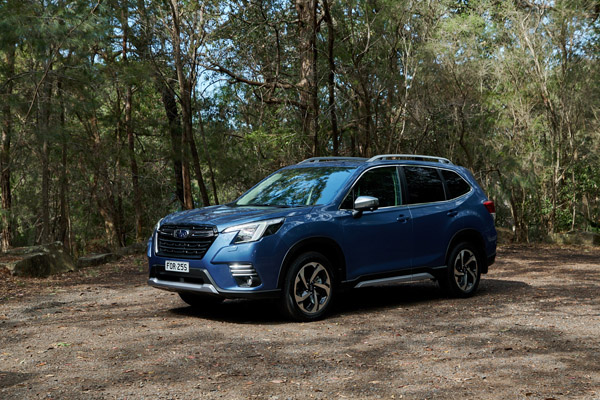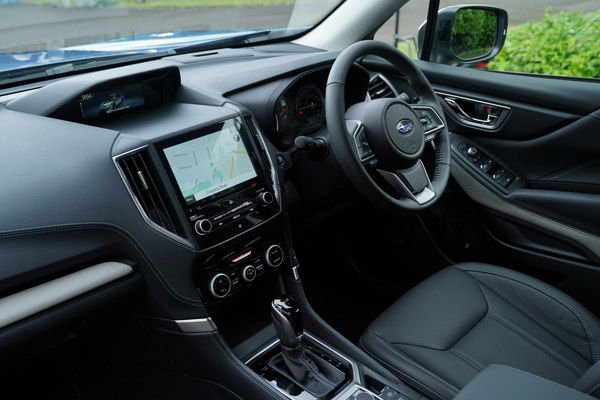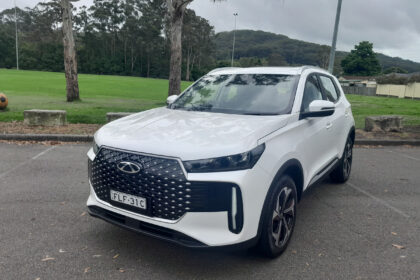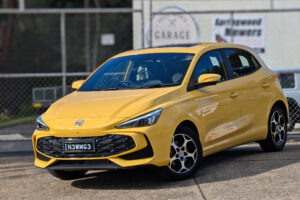
The Subaru Forester came to life in1997 as a bare-bones, no-nonsense cross-over vehicle
ready to take on the likes of the Toyota RAV4 and Suzuki Grand Vitara.
Using the Impreza platform, but built in the style of a station wagon, with a taller stance,
higher hip-point seating and all-wheel drive, over the years it has gained in size,
sophistication and popularity, becoming a top seller. Indeed, Subaru recently celebrated
300,000 Forester sales in Australia.
A late addition to the small SUV segment a quarter of a century ago, the Forester, along
the way, has boasted some of the Japanese automobile manufacturer’s most advanced
driving aids and safety systems. It still does.
For example, in Australia, EyeSight Driver Assist, which scans the road ahead for danger,
first introduced on the range-topping Liberty and Outback models in 2012, was ahead of
its time. By 2021, 92 per cent of Subaru vehicles sold in Australia were equipped with it.
The subject of some minor design upgrades in 2022, the MY23 range opens at $37,890,
plus on-road costs for the 2.5i petrol and peaks with the Hybrid S at $49,340. Price
increases range from $1900 to $2150, which Subaru Australia claims are due to production
and logistic costs.
The MY23 model stays much the same except for minor specification changes, with the
high-spec Forester 2.5i Sport, 2.5i-S (the test vehicle) and Hybrid S all getting an auto-
dimming rear-view mirror as standard. The outgoing Dark Blue Pearl exterior paint option
has been replaced by Sapphire Blue Pearl.

All Forester variants now include Lane Centring Function, Lane Departure Prevention and
Autonomous Emergency Steering, designed to avoid frontal collisions, lane drifting and
low speed impacts. It can ‘lock on’ to vehicles directly in front and, when used together
with Adaptive Cruise Control, can slow, stop and accelerate to maintain a safe driving
distance.
It also recognises pedestrians, motorcycles and cyclists within its field of vision. Depending
on conditions, the Pre-Collision Braking System can help to minimise impact and damage.
If the speed is less than 30 km/h, the car can be brought to a complete stop before impact.
Then there’s the Driver Monitoring System that uses a camera to monitor the driver for
signs of fatigue or distraction and warns them if it detects that the driver is not focused or
keeping eyes on the road ahead. It also features advanced temperature adjustment,
allowing the driver to have complete control of the temperature through simple hand
gestures.
The 2023 Subaru Forester has a five-year, unlimited kilometre warranty with three or five-
year servicing schemes, costing $1277.90 and $2422.38, respectively.

STYLING
The more things change, the more they stay the same. Unlike many of its younger rivals,
the latest Forester has eschewed modern design trends with a somewhat staid station
wagon-like appearance. And, with misty-eyed memories and massive sales, that is how
the fans, and maker, like it.
INTERIOR
The Forester is a spacious five-seater with the 2.5i-S perches clad in quality leather
upholstery. Seating height and a good expanse of glass all round make for good visibility.
Twin cup holders are centred between driver and front seat passenger. A large
comfortable armrest is home to a storage area with USB ports. Door pockets are
generous.
Rear passengers are treated to spacious surroundings thanks to the Forester’s traditional
station wagon styling. Also on hand are two USB ports and air vents. Boot space also
takes advantage of the vehicle’s square old-world character. There is 498 litres with all
seats up and 1704 litres with rear two seat backs folded. There is room under the floor for
a full-size spare wheel – an off-road bonus.
INFOTAINMENT
The MY23 model has maintained a full house of information displaying fixtures and fittings
of former Foresters. With three sets of screens, it does veer on the side of
overcapitalisation.
Main centre of infotainment focuses on a centre-dash mounted 8-inch screen with wired
Apple CarPlay and Android Auto connectivity, integrated satellite navigation, and AM / FM
/ DAB+ radio, the last from an eight-speaker harman / kardon sound system.
ENGINES / TRANSMISSIONS
The MY23 non-hybrid models are powered by the same naturally aspirated 2.5-litre
horizontally opposed four-cylinder engine putting out 136 kW peak power and 239 Nm of
torque.
Mated with a continuously variable automatic transmission, power is distributed
permanently through all four wheels.
SAFETY
ANCAP awarded the Subaru Forester a five-star safety score in 2019, with the latest list of
standard safety equipment on all models including autonomous emergency braking and
steering, blind-spot monitoring, rear cross-traffic alert, lane-departure warning, lane-keep
assist, lane centring and adaptive cruise control.
As mentioned above, all but the base 2.5i come standard with a facial recognition camera to
detect driver drowsiness or distraction, as well as rear autonomous emergency braking.
DRIVING
Fire up the engine and the cabin is filled with the signature sound of the 2.5 Subaru
horizontally opposed unit – some might find it intrusive – Boxer fans not so. There’s no
mistaking the note through the whole rev range, with responsive action to the accelerator
pedal.
All Foresters run on 91RON regular unleaded fuel, with non-hybrid combined consumption
of 7.4 litres per 100 kilometres. The test car recorded 11.9 litres per 100 kilometres in the
daily city commute and 6.1 litres per 100 kilometres when cut free on the open road.
All-wheel drive has the Forester steady and reliable on bitumen business, while ventilated
discs all round maintain a high level of efficiency when called on in spirited driving.
Off road going can be tamed by X-Mode, a system that has two modes – Snow / Dirt and
Deep Snow / Mud – each yielding improved grip and traction in low-speed and slippery
conditions, and gear selection to suit the terrain.
The 220 mm of ground clearance puts the Forester up with more hardened 4x4s, tackling low-
range off-roading without worries for driver or passengers. Braked towing is rated at 1800 kg.
SUMMARY
Subaru Australia claims 97 per cent of Foresters sold in the past 10 years are still on the
road today, so that says a lot about the pedigree of the vehicle. The addition of hybrid
technology, plus the promise of turbo power, are bound to keep Forester to the forefront of
responsible driving.
RATINGS
Looks: 5/10
Performance: 7/10
Safety: 8/10
Thirst: 6/10
Practicality: 7/10
Comfort: 8/10
Tech: 7/10
Value: 5/10
AT A GLANCE
MODEL LINE-UP
Forester 2.5i: $37,890
Forester 2.5i-L: $40,290
Forester 2.5i Premium: $43,090
Forester Hybrid L: $43,290
Forester 2.5i Sport: $44,840
Forester 2.5i-S: $46,340
Forester Hybrid S: $49,340
Note: These prices do not include government or dealer delivery charges. Contact your
local Subaru dealer for drive-away prices.
SPECIFICATIONS (Subaru Forester 2.5i-S 4-cylinder petrol, CVT automatic, AWD SUV)
ENGINE:
Capacity: 2.498 litres
Configuration: Four cylinders horizontally opposed
Maximum Power: 136 kW @ 5800 rpm
Maximum Torque: 239 Nm @ 4400 rpm
Fuel Type: Petrol 91 RON
Combined Fuel Cycle (ADR 81/02): 7.4 L/100km
Emissions CO2: N/A
DRIVELINE: Boxer four-cylinder, CVT automatic, all-wheel drive
DIMENSIONS, WEIGHT AND CAPACITIES:
Length: 4640 mm
Wheelbase: 2627 mm
Width: 1815 mm
Height: 1730 mm
Turning Circle: 10.8 metres
Kerb Mass: 1576 kg
Fuel Tank Capacity: 63 litres
BRAKES:
Front: Ventilated disc
Rear: Ventilated disc
STANDARD WARRANTY:
Five years / unlimited kilometres








